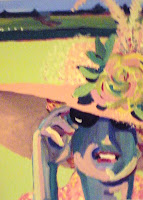I've started painting again - with varying and sometimes surprising results.
 |
| Self-portrait: Diagnosis |
work and provide the details.
Most surprising is the emotion revealed in some of my new pieces. My husband says they are great -- and they scare him to bits.I'm working on two series of self-portraits. One, the "scare to bits" group, is a visual examination of my reaction to ALS. They are very personal and, I am surprised to see, pretty powerful.
The "Diagnosis" self-portrait above is a example
The second group is a "bucket list" series, fun, somewhat frivolous paintings of
myself in settings and activities on my gotta-do list. They are much more cheerful in color and mood, but they 're still pretty strong personal statements: I really, really want to visit these places and do these things! (I have long wanted, for example, to go to a major horse race, wear a big frou-frou hat, the whole nine yards. So my daughter and I, I hope, are going to opening weekend at Saratoga next summer --. big brim, flowers, feathers and all!)
The very best thing about these paintings, fun or serious, art or not, lies in the doing. Pushing paint around, playing with color, getting myself all splattered, even cleaning my brushes provide great physical therapy. And trying to give visual voice to my often chaotic thoughts is turning out to be the best psychological and spiritual therapy I could ever devise.
* * *
I would really like to hear from other PALS artists. How do you fill your creative needs? How has your approach changed as the disease progresses? Does art provide satisfaction? Frustration? Release? What do you create? Let's get a good discussion going....
 |
| Self-portrait with Race Day Hat: Bucket List #1 |
The very best thing about these paintings, fun or serious, art or not, lies in the doing. Pushing paint around, playing with color, getting myself all splattered, even cleaning my brushes provide great physical therapy. And trying to give visual voice to my often chaotic thoughts is turning out to be the best psychological and spiritual therapy I could ever devise.
* * *
I would really like to hear from other PALS artists. How do you fill your creative needs? How has your approach changed as the disease progresses? Does art provide satisfaction? Frustration? Release? What do you create? Let's get a good discussion going....
 |
| Self-portrait with Hands |
 |
| Self-portrait with Glacier: Bucket List #3 |




